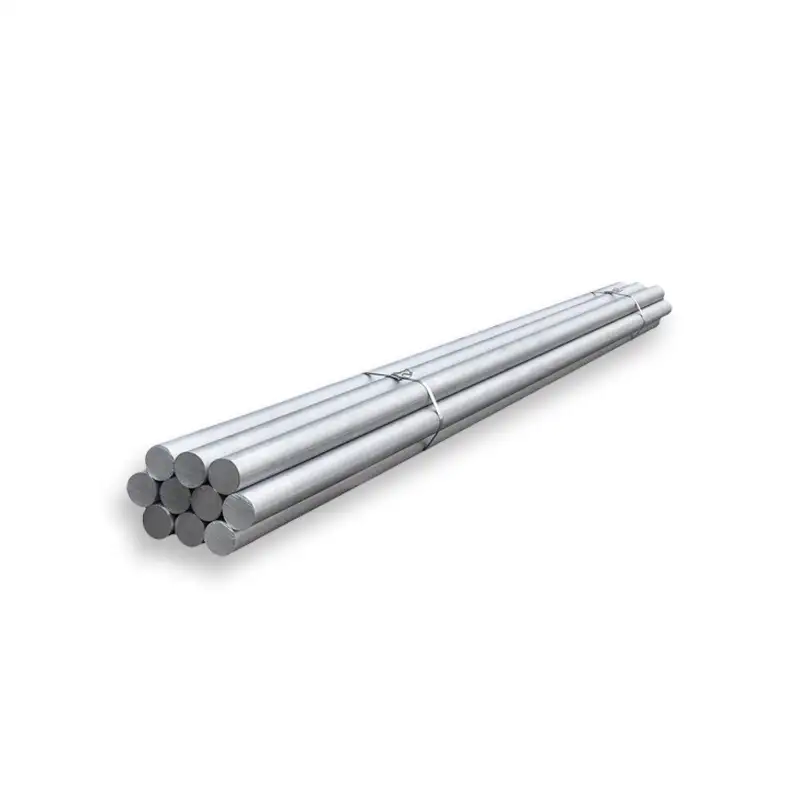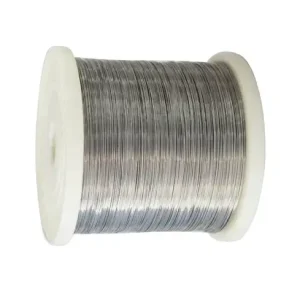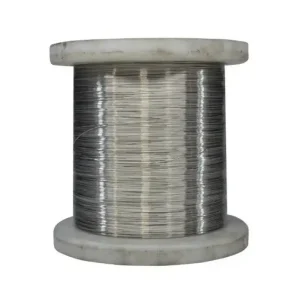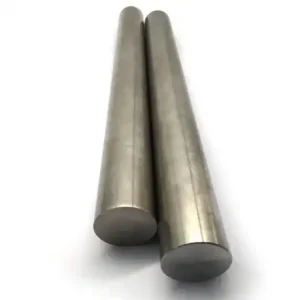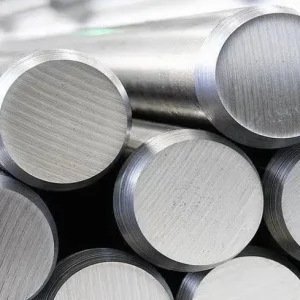Inconel X-750 (UNS N07750, W. Nr. 2.4669) is a precipitation-hardenable nickel-chromium superalloy prized for high strength and excellent resistance to oxidation and relaxation at elevated temperatures — making it a first-choice material for high-temperature springs, turbine fasteners, and aerospace components. For buyers who require certified material with fast factory dispatch, MWalloys supplies Inconel X-750 bars and wire at competitive factory prices from China with short lead times for stock items.
What is Inconel X-750?
Inconel X-750 is a nickel-chromium-iron based superalloy that has been made precipitation-hardenable by the controlled addition of aluminum and titanium. It is manufactured to retain high tensile strength and creep resistance up to roughly 700°C (≈1300°F) in many heat-treated conditions; it also resists relaxation (stress loss) at elevated temperatures — a critical trait for springs and bolting that must maintain preload. These core attributes explain its widespread use in aerospace, power generation, petrochemical, and nuclear applications.
Specifications & standards
-
UNS / EN / Werkstoff / WNr: UNS N07750 / W. Nr. 2.4669.
-
Common material specifications used for bar / wire / strip: ASME/ASTM/AMS standards typically referenced for X-750 forms include ASME/ASTM/AMS documents such as AMS 5542 (strip/foil), AMS 5698/5699 (wire), AMS 5667/5668/5669 (bar/rod requirements), and ASME SB-637 (bar/rod). Exact spec applicability depends on product form and purchaser requirements.
Chemical composition
Below is a practical composition snapshot used widely in engineering tables. Individual mill certificates will give actual lot analysis.
Nominal composition (typical ranges)
-
Nickel (Ni): ≈70% (balance)
-
Chromium (Cr): 14.0 – 17.0%
-
Iron (Fe): ≈5.0 – 9.0%
-
Titanium (Ti): 2.25 – 2.75%
-
Aluminum (Al): 0.40 – 1.00%
-
Niobium + Tantalum (Nb+Ta): 0.70 – 1.20% (often listed small)
-
Carbon (C): ≤0.08%
-
Manganese (Mn), Silicon (Si), Copper (Cu), Cobalt (Co), Sulfur (S) — trace limits.
Common equivalents / trade names
-
Inconel® X-750 (Special Metals trade name) — UNS N07750.
-
European material numbering: W. Nr. 2.4669.
-
Other sellers may list it under names like Alloy X-750, Nickel X-750 or vendor trade names; confirm UNS and spec.
Mechanical & thermal properties
Note: the values below are representative. Always use mill test certificates (MTC) and contract test data for final design calculations.
| Property | Typical value / notes |
|---|---|
| Density | ≈ 8.28 g/cm³ (8.28 g/cc) = 8280 kg/m³ (≈0.299 lb/in³). |
| Room-temp tensile strength (PH/aged) | Typical ultimate tensile strength (UTS) can be > 1250 MPa (≈181 ksi) depending on temper; specific heat treatment alters values. |
| Yield strength | Strongly temper-dependent; aged conditions commonly yield the high values required for springs. |
| Creep/rupture capability | Useful up to ~700°C (≈1300°F) for many heat-treated conditions; limited retention beyond ~700–800°C for full precipitation hardening. |
| Oxidation resistance | Good up to ~980°C (≈1800°F) for short durations; long-term strength retention lower at these extreme temperatures. |
| Typical service range | Cryogenic up to ~700°C (service properties diminish above ~700–800°C). |
Heat treatment & tempering notes (bar & wire)
Because X-750 is precipitation hardened, the mechanical properties are controlled by aging cycles that precipitate γ′/γ″ phases (Al/Ti compounds). Typical commercial sequences include:
-
Solution anneal (for homogenization) — followed by water quench.
-
Aging (two-step or three-part aging depending on spec) to produce the desired combination of strength and relaxation resistance.
-
For springs, a “spring temper + aged” condition is common; for load-bearing bolts and aerospace parts, more stringent AMS/ASME aging cycles and documentation may apply. For any critical part, request the supplier’s heat-treatment record and hardness/tensile test reports.
What is Inconel X750 used for?
-
High-temperature springs (valve springs, turbo machinery springs) — due to low relaxation and high creep resistance.
-
Gas turbine components & fasteners — bolts, retention hardware subjected to thermal cycles.
-
Aerospace and rocket motor parts — fasteners, retaining rings, hot-air ducts.
-
Nuclear and petrochemical components where combined strength and corrosion resistance at elevated temperature matter.
Inconel X-750 bar — sizes, stock lengths, and weight table
Density used for calculation: 8.28 g/cm³ = 8280 kg/m³. (standard literature value).
Below are typical round bar diameters and weights (metric): (weights rounded to four decimals where helpful).
| Diameter (mm) | Weight per meter (kg/m) | Weight per foot (kg/ft) |
|---|---|---|
| 6 | 0.2341 kg/m | 0.7681 kg/ft |
| 8 | 0.4162 kg/m | 1.3655 kg/ft |
| 10 | 0.6503 kg/m | 2.1336 kg/ft |
| 12 | 0.9364 kg/m | 3.0723 kg/ft |
| 16 | 1.6648 kg/m | 5.4619 kg/ft |
| 20 | 2.6012 kg/m | 8.5342 kg/ft |
| 25 | 4.0644 kg/m | 13.3348 kg/ft |
| 30 | 5.8528 kg/m | 19.2021 kg/ft |
| 40 | 10.4050 kg/m | 34.1370 kg/ft |
| 50 | 16.2577 kg/m | 53.3390 kg/ft |
| 60 | 23.4111 kg/m | 76.8082 kg/ft |
| 80 | 41.6198 kg/m | 136.548 kg/ft |
| 100 | 65.0310 kg/m | 213.356 kg/ft |
| 150 | 146.3197 kg/m | 480.051 kg/ft |
| 200 | 260.1239 kg/m | 853.425 kg/ft |
How these numbers were obtained: circular cross-section area × density (8,280 kg/m³) gives kg per meter. Use actual diameter and density from the mill certificate for the precise weight.
Common stock lengths: 1 m, 2 m, 3 m, 6 m; many mills and distributors also stock cut-to-length and forged billets. Confirm straightness and tolerance specifications if the piece is to be machined to aerospace tolerances.
Corrosion & oxidation behavior — practical guidance
-
General corrosion: X-750 resists general corrosion in many oxidizing environments due to its chromium content; however, aggressive chloride or sulfur environments need evaluation.
-
Oxidation: forms protective oxide layers that provide utility at elevated temperature; short exposures to very high temperature may be tolerated, but prolonged service at extreme temperature will reduce precipitation hardening benefits.
-
Hydrogen embrittlement & stress corrosion cracking: like many nickel alloys, assessment under specific service environments should be done; NACE/ISO15156 considerations apply for sour (H2S) service.
Fabrication, welding, and inspection notes
-
Machining: X-750 machines more slowly than common stainless steels; maintain rigid set-up, sharp carbide tools, and moderate feeds to avoid work hardening. Use coolant recommended for nickel alloys.
-
Welding: weld filler selection and post-weld heat treatment must follow the applicable AMS/ASME requirements. For critical applications, welding may require controlled preheat and post-weld aging to re-establish precipitation hardening. For springs, welding is generally avoided; instead, mechanical fastening or cold forms are preferred.
-
NDT & testing: request full MTC with tensile, hardness, and chemical analysis when procurement is for safety-critical parts. Ultrasonic or dye-penetrant inspection often used for forgings and finished components.
How X-750 compares with popular nickel alloys
-
Inconel 718 — 718 frequently achieves higher strength at comparable temps and contains Nb (niobium) and Mo (molybdenum); 718 is age-hardening too, but composition and performance envelope differ. Use 718 where higher static strength and certain fabrication properties are needed; use X-750 when superior relaxation resistance for springs is required.
-
Inconel 625 — 625 has excellent corrosion resistance and high strength but is not precipitation-hardenable like X-750; 625 excels in highly corrosive environments (high Mo content). Price and selection depend on corrosion vs. creep/relaxation priorities.
-
A-286 — A-286 (iron-nickel-based) can be a substitute in some spring applications when temperatures are lower; assess vendor data for specific replacements.
2025 price snapshot — USA, Europe, China
Important: alloy prices change with global nickel markets, logistics, certification, lot size, and product form (bar vs. wire vs. strip). The table below is a market snapshot representative for mid-2025 and intended for budgetary comparison only. Always request a firm pro-forma quoting the exact material form, certification (AMS/ASME), quantity, and lead time.
| Region / Channel | Typical 2025 price (USD per kg) | Notes / drivers |
|---|---|---|
| China — factory / small qty (direct) | ~$35 – $60 / kg | Competitive factory pricing for bar/wire when buying direct from mills or Chinese stockists; lower freight/import cost for domestic buyers. Example listing for Inconel X-750 wire/bar from Chinese suppliers. |
| Europe — distributor / small orders | ~$60 – $95 / kg | Distributor premiums, VAT, import duties, and AMS/EN certification requirements increase unit cost. |
| USA — authorized distributor / certified aerospace lots | ~$70 – $110 / kg | Higher prices reflect traceability, aerospace certifications, testing, and landed costs. Small order premiums are common. |
Why ranges are wide: product form (wire vs. bar), temper/heat treatment, AMS/ASME test certificates, batch size, and expedited shipping are the main cost drivers.
Buying tips, certificates & why pick MWalloys
If your order is for critical components, insist on:
-
Full Mill Test Certificate (MTC) (chemical + mechanical).
-
Clear statement of applicable standard (ASME SB-637, AMS 5667/5668/5669, AMS 5698/5699 for wires).
-
Heat-treatment records (age cycles) and hardness readings where needed.
-
Traceability (heat number to certificate).
About MWalloys (brief, non-promotional technical note)
MWalloys stocks Inconel X-750 bar and wire in common diameters and offers direct factory pricing from China — typically lower landed cost for buyers willing to purchase directly and accept standard factory lead times. For urgent stock items we maintain fast dispatch for stocked sizes; please request a stock confirmation and CR (certificate) copy with your RFQ.
FAQs
-
Is Inconel X-750 the same as X750?
Yes, X-750 and X750 refer to the same alloy (UNS N07750). Confirm the UNS if the exact chemistry is critical. -
What temperatures can X-750 be used at?
Service strength is reliable up to around 700°C (≈1300°F) depending on temper; useful short-term oxidation resistance extends higher but precipitation hardening effectiveness reduces beyond 700–800°C. -
Can X-750 be welded?
Yes, but welding requires correct filler, qualified procedure, and may need post-weld heat treatment to regain properties for critical parts. Avoid for delicate springs unless under specialist procedures. -
What is the density?
≈8.28 g/cm³ (8280 kg/m³) — use manufacturer data for final mass calculations. -
Is X-750 used in aerospace?
Yes, X-750 is widely used for springs, fasteners, and high-temp hardware in aerospace applications. -
What standards cover X-750 bar?
ASME/ASTM/AMS documents such as ASME SB-637, AMS 5667/5668/5669 (bars/rods), and relevant EN/Werkstoff numbers. Confirm contract spec. -
Can I replace X-750 with 718?
Not automatically — although both are nickel superalloys, differences in alloying and heat-treatment behavior mean substitution requires engineering review. -
Price per kg — what to expect?
Expect wide ranges by region and form; see the 2025 snapshot above. Always ask for a firm quote. -
How to specify X-750 in a purchase order?
Include alloy designation (UNS N07750 / W. Nr. 2.4669), form, size/length, required standard (AMS/ASME/ASTM), certificate type (MTC / EN10204), and delivery terms. -
Is X-750 magnetic?
In its annealed or aged states it is essentially non-magnetic to weakly paramagnetic due to high nickel content; specific magnetic response depends on cold work and heat treatment.

